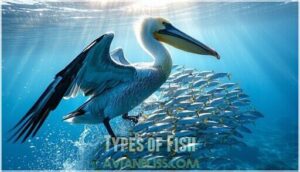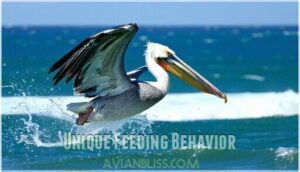This site is supported by our readers. We may earn a commission, at no cost to you, if you purchase through links.

These coastal champions nearly vanished in the 1970s due to DDT poisoning, but they’ve bounced back like nature’s own comeback kid.
You can find them swooping along shorelines from California to Florida, where they’ve mastered the art of precision diving from heights up to 60 feet.
Their recovery story reads like a conservation fairytale – from endangered species list to thriving populations in just decades.
But there’s more to these feathered acrobats than meets the eye.
Table Of Contents
- Key Takeaways
- Brown Pelican Overview
- Brown Pelican Habitat
- Brown Pelican Diet
- Brown Pelican Conservation
- Brown Pelican Life Cycle
- Frequently Asked Questions (FAQs)
- How rare are brown pelicans?
- Where are brown pelicans found in the US?
- Why did the brown pelican go extinct?
- How do you identify a brown pelican?
- How fast can a brown pelican fly?
- Do brown pelicans migrate seasonally?
- Can brown pelicans swim underwater?
- How do brown pelicans communicate with each other?
- Are brown pelicans related to other seabird species?
- How long do brown pelicans live?
- Conclusion
Key Takeaways
- You’ll recognize brown pelicans by their massive 6-7 foot wingspan, 18-inch bills with expandable throat pouches, and their spectacular plunge-diving fishing technique from heights up to 60 feet.
- You’re witnessing one of conservation’s greatest success stories – brown pelicans nearly went extinct in the 1970s due to DDT poisoning but have bounced back to thriving populations after the pesticide was banned.
- You’ll find these coastal champions along America’s Atlantic, Pacific, and Gulf coasts, where they prefer isolated island nesting sites and feed primarily on schooling fish like menhaden and sardines.
- You can observe their unique feeding behavior as nature’s most dramatic fishermen – they’re the only pelican species that plunge-dives, using their 2.5-gallon throat pouches like living scoop nets to catch fish.
Brown Pelican Overview
You’ll easily recognize these massive coastal birds by their huge bills and stretchy throat pouches, which they use like fishing nets to scoop up small fish.
These remarkable seabirds, once nearly extinct due to DDT poisoning, have made an incredible comeback and now thrive along America’s Atlantic, Gulf, and Pacific coasts, with their populations being a testament to remarkable conservation efforts.
Physical Characteristics
You’ll recognize a brown pelican (Pelecanus occidentalis) by its massive 6-7 foot wingspan size and distinctive 18-inch bill length with an expandable throat pouch.
These impressive birds showcase fascinating regional variations in their physical characteristics – Pacific Coast adults display vibrant red throat skin during breeding, while Atlantic populations feature greenish-black coloration.
Their plumage coloration shifts from gray-brown bodies to striking yellowish-gold heads, creating nature’s perfect fishing machine weighing up to 9 pounds.
Behavior and Feeding
You’ll witness Brown Pelicans’ spectacular plunge-diving mechanics as they soar 30-60 feet above water, then crash bill-first with whale-like splashes.
Their fishing techniques involve stunning fish on impact before scooping them into expandable throat pouches.
Watch them drain water from these 2.5-gallon pouches before swallowing prey whole, which makes them unique among seabirds due to this pelican feeding behavior.
Habitat and Distribution
You’ll spot brown pelicans along America’s entire coastline, from British Columbia down to Peru.
These coastal birds call the Atlantic, Pacific, and Gulf coasts home, with distinct regional variations in their appearance.
They prefer island nesting sites on isolated coastal ecosystems, following predictable migration routes.
Human impact has shaped their distribution, but they’ve bounced back remarkably in gulf coast wildlife habitats, showing a notable ability to thrive in coastal ecosystems.
Brown Pelican Habitat
You’ll find brown pelicans cruising along America’s Atlantic, Pacific, and Gulf coasts, where they’ve mastered the art of coastal living from British Columbia all the way down to Peru.
These impressive birds stick close to saltwater environments, rarely venturing inland, and they’re smart enough to choose small, isolated islands for nesting to keep raccoons and other predators at bay, which is a key aspect of their nesting strategy.
Coastal Regions
You’ll find brown pelicans thriving along America’s Atlantic coast, Gulf shores, and Pacific waters.
These coastal birds call saltwater wetlands, estuaries, and rocky jetties home.
However, coastal ecosystems face mounting pressure from human encroachment and habitat loss.
Pollution effects and climate change threaten gulf coast wildlife populations, making conservation of these marine environments critical for pelican survival.
Migration Patterns
Unlike most birds that follow strict migratory schedules, brown pelican migration patterns surprise researchers with their flexibility.
You’ll witness coastal migration as flocks move north after breeding, then return south for winter warmth.
Seasonal movements depend on food availability and weather conditions, which influence juvenile migration to often involve wandering inland.
Juvenile migration often involves wandering inland, while breeding dispersal creates complex distribution patterns across North America’s coastlines.
Nesting Sites
Brown pelicans choose their nesting colonies with the precision of real estate experts.
You’ll discover these smart birds favor small, isolated coastal islands where predators can’t easily reach their precious eggs and chicks.
Key nesting site characteristics:
- Island selection prioritizes isolation from mainland predators like raccoons
- Colony size ranges from dozens to thousands of breeding pairs
- Site fidelity brings birds back to successful locations year after year
These locations are sometimes referred to as Pelican nesting islands.
Brown Pelican Diet
You’ll discover that brown pelicans are the ocean’s most dramatic fishermen, launching themselves 30 to 60 feet from the sky to snatch up menhaden, mullet, and other small schooling fish with their massive throat pouches.
They’re the only pelican species that plunge-drops for their meals, creating whale-sized splashes that can be seen from quite a distance.
Types of Fish
Your feathered friend’s fish diet revolves around schooling fish that swim near the surface.
Menhaden nutrition provides 90% of their breeding season fuel, while mullet abundance supports year-round feeding. Fish size matters – they prefer smaller specimens that fit their throat pouch perfectly.
| Primary Fish | Diet Percentage |
|---|---|
| Menhaden | 90% (breeding season) |
| Pacific Sardines | 26% (Southern California) |
| Anchovies | Major component |
Prey availability determines their marine ecosystem success, making bird feeding habits incredibly specialized.
Hunting Strategies
You’ll witness these remarkable hunters execute precision strikes that’d make fighter pilots jealous.
Their dive mechanics involve soaring 10-60 feet above water, spotting fish below, then plummeting bill-first like guided missiles.
Here’s how they master their craft:
- Scout from heights – Circling to locate fish schools
- Calculate trajectory – Adjusting for water refraction
- Execute plunge-diving – Hitting water at 40+ mph
- Deploy scoop net – Opening massive pouch capacity
- Achieve prey stun – Using impact force before capture
Unique Feeding Behavior
Picture yourself watching nature’s most dramatic fishing show.
You’ll witness brown pelicans execute spectacular plunge-diving mechanics, dropping 60 feet like feathered missiles. Their air sac cushion absorbs the bone-jarring impact while they stun fish below.
That expandable pouch acts like a living scoop net, holding 2.5 gallons before draining water and swallowing prey whole.
| Feeding Feature | Capacity/Range | Purpose |
|---|---|---|
| Throat Pouch | 2.5 gallons | Scoop net for fish |
| Diving Height | 10-60 feet | Stun fish impact |
| Air Sac System | Full body coverage | Cushion diving shock |
Brown Pelican Conservation
You’re looking at one of America’s greatest conservation victories, where the brown pelican bounced back from fewer than 100 birds in the 1970s to thriving populations today.
When scientists banned DDT in 1972, these coastal giants proved that smart protection efforts can save species from disappearing forever.
Recovery From DDT
During the 1970s, you’d witness one of conservation’s greatest comebacks when DDT bans sparked the brown pelican’s remarkable environmental recovery.
You’d be amazed by nature’s resilience when humans step up to protect what matters most.
This pesticide pollution had caused devastating eggshell thinning, creating a population bottleneck with fewer than 100 birds surviving.
Today’s conservation success story proves that continued monitoring and DDT alternatives can reverse even the most severe ecosystem impacts.
Current Threats
While DDT’s ban saved these magnificent birds, you’ll find they’re still fighting for survival.
Oil spills coat their feathers, causing hypothermia.
Plastic pollution fills their stomachs, leading to starvation.
Fishing nets entangle them, while climate change destroys nesting sites through hurricanes.
Pesticide pollution continues creating thin-shelled eggs that crack during incubation, threatening future generations.
Effective oil spill mitigation is essential to their survival.
Conservation Efforts
Multiple organizations work together to protect Brown Pelican populations through habitat protection and wildlife conservation programs.
You’ll find conservationists removing invasive species, restoring coastal areas, and improving water quality where these birds live.
The Migratory Bird Treaty Act provides legal protection, while $49 million in funding supports habitat restoration projects.
This bird species conservation effort guarantees future generations can witness these remarkable coastal survivors, thanks to wildlife conservation programs.
Brown Pelican Life Cycle
You’ll discover that brown pelicans follow a fascinating annual cycle that begins when pairs choose isolated coastal islands for their spring courtship rituals.
Once you understand their breeding timeline, from nest-building through the 30-day incubation period to raising their young, you’ll appreciate how these remarkable seabirds have successfully rebuilt their populations across America’s coastlines, which is a truly fascinating process.
Mating Habits
Brown pelicans become romantic dancers during breeding season, performing elaborate courtship rituals that’d make you smile.
Males strut around potential mates, showing off their vibrant yellow head plumage and bright throat pouches.
Pair bonding happens through synchronized head movements and bill touching, creating lasting bonds for successful reproduction, which is a result of these mate selection displays that guarantee strong partnerships before nest building begins.
Nesting Behavior
Once you’ve found your mate, you’ll witness remarkable colony formation as Brown Pelican pairs gather on coastal islands.
These birds create simple nests using twigs, grass, and debris they collect nearby.
Their nesting habits involve building on ground or low shrubs, staying close together for protection.
Smart bird breeding strategy – there’s safety in numbers when nesting threats like predators lurk around these vulnerable coastal colonies.
Incubation and Chick Rearing
How do Brown Pelican parents guarantee their eggs develop properly? You’ll find incubation lasts about 30 days, with both adults sharing duties.
Their webbed feet warm the eggs while providing essential parental care. Once hatched, chick development requires constant feeding and protection.
Nestling mortality remains high, but dedicated parents boost fledgling success through intensive care during these vulnerable weeks, which is crucial for their development.
Frequently Asked Questions (FAQs)
How rare are brown pelicans?
Once numbering fewer than 100 birds in the 1970s, you’ll find these coastal giants aren’t rare anymore. They’ve made a remarkable comeback since DDT’s ban, earning "Least Concern" status today.
Where are brown pelicans found in the US?
You’ll spot these magnificent coastal birds along the Pacific, Atlantic, and Gulf coasts throughout the southern and western United States, from California to Florida, gliding gracefully over warm ocean waters.
Why did the brown pelican go extinct?
Actually, you’re looking at a conservation success story!
DDT pesticides caused their eggs to crack during incubation, nearly wiping them out by the 1970s.
They’ve bounced back beautifully since DDT was banned.
How do you identify a brown pelican?
You’ll recognize this coastal giant by its massive size, long bill with stretchy throat pouch, and distinctive plunge-diving behavior.
Look for gray-brown plumage, white head during breeding season, and characteristic low gliding flight over water, which are all key identifiers of this species, with its distinctive features being quite notable.
How fast can a brown pelican fly?
You’ll see these coastal fliers cruising at around 25-30 mph during normal flight.
When they’re diving for fish, they can reach speeds up to 40 mph as they plunge headfirst into the water.
Do brown pelicans migrate seasonally?
Migration patterns aren’t exactly globe-trotting adventures for these coastal birds.
You’ll find brown pelicans making short seasonal movements north along Atlantic and Pacific coasts after breeding.
Then returning south when winter arrives.
Can brown pelicans swim underwater?
You won’t see brown pelicans swimming underwater like ducks or loons. They’re surface feeders who dive from above to catch fish, but they don’t actually swim beneath the water’s surface.
How do brown pelicans communicate with each other?
Wings slicing through salty air, you’ll hear brown pelicans grunt, bark, and hiss during breeding season.
They use bill-clapping displays, head movements, and throaty vocalizations to communicate with mates and establish territory boundaries effectively.
Are brown pelicans related to other seabird species?
You’ll find brown pelicans are closely related to other pelican species within the Pelecanidae family.
They’re part of the Pelecaniformes order, sharing ancestry with cormorants, gannets, boobies, and frigatebirds – all specialized seabirds.
How long do brown pelicans live?
You’ll find these coastal giants typically live 15-25 years in the wild, though some lucky individuals have reached 30+ years.
Their lifespan depends on food availability, predator threats, and environmental conditions affecting their ocean habitat.
Conclusion
Like knights of old defending their coastal kingdoms, the brown pelican has reclaimed its rightful place along America’s shores.
You’ve witnessed one of nature’s greatest comeback stories – from DDT’s devastating blow to today’s thriving populations.
These remarkable birds remind us that dedicated conservation efforts really work.
Next time you’re at the beach, watch for their spectacular dives and remember: you’re seeing living proof that species can recover when we give them the chance they deserve.










